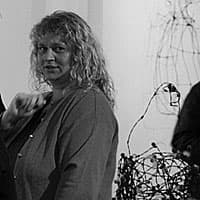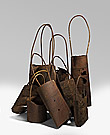Lorraine CONNELLY-NORTHEY

Three Rivers Country pays homage to my mother’s knowledge of water on Country. The work is my interpretation of an o’possum skin cloak with incisions depicting rivers and koolimans.[1] The work represents the land of the ‘Waradgerie Winnowers’, my mother’s tribal boundary, Waradgerie Country.
Mum was born and raised on the banks of freshwater rivers, in shanties constructed out of discarded scraps of rusty tin and iron, living off the land, its waterways and government handouts. Mum recalls the dangers of these rivers, the lives lost and the unexplained sightings of their unknown creatures.
Dad would take me out bush and teach me what he had learnt about Mum’s culture and about the bush. He taught me about the river, its tributaries, lake systems, Aboriginal sites and artefacts, nature, animals and plants, how to read rain clouds and the many aspects of water irrigation taught to him by his farming father.
It is only natural then that Narrbong, or ‘bag pipes’ (which Dad prefers), pays homage to my father and his sound knowledge of water. This installation has handles of rusted household water-pipes and pouches made from rusted, pivoted irrigation piping representative of non-Indigenous ways of sourcing water for survival.
Lorraine Connelly-Northey’s art practice has developed primarily outside her traditional Country. Born in 1962 and raised at Swan Hill in western Victoria, on Wamba Wamba traditional lands, she was influenced by an amalgam of her father’s Irish ancestry and mother’s Waradgerie (Wiradjuri) heritage.
Reworking textural surfaces, Connelly-Northey bends, shapes, twists, stitches and merges found materials to create contemporary works of art that transform European industrialised waste into culturally iconic sculptural forms while alluding to little-known traditional weaving techniques and stories connected to her Country. The artist acquired this skill from her father on their many collecting trips. Connelly-Northey constantly sees the potential of found material and how it can be reworked and thinks about ways to build on new ideas, approaches and more efficient techniques.
Connelly-Northey first started making narrbongs (dilly bags) in 2002; they were small in scale and engagingly intimate. In 2007, they became much larger, their formal qualities more sculptural. Connelly-Northey evokes in her work the reclamation of detritus not only as a signifier of colonisation and dispossession but also as a potent symbol of cultural resilience and creative innovation. Narrbongs, in their diverse forms, as traditionally created by Waradgerie people, illustrate the collecting of commodities—from food to important personal items. They are made in fine detail from natural fibres. This cultural practice is a maternal undertaking passed on from mother to daughter and grandmother to granddaughter. The narrbongs Connelly-Northey creates, and the larger sculptural forms they reflect, are an extension and derivative of this practice, taking on new meanings that are firmly anchored by a strong connection to her matriarchal culture.
Connelly-Northey broadens the inspiration of these traditions by innovatively weaving rusted sheets of metal and wire with metal gauze and other forms of disused agricultural material to create her large installation Three Rivers Country 2010. This ambitious work is the largest she has created to date and marks a point of departure from the sculptural forms seen in her earlier narrbongs. Three Rivers Country illustrates a grander narrative of cultural-mapping intricately connected to her mother’s Country while referencing her grandfather Alfred ‘Knocker’ Williams’s family connection to the Wongaibon people, whose traditional lands border her grandfather’s to the north-west. Significantly, it also marks the first time Connelly-Northey has created a work while living in her maternal Country. Here, the artist ponders the importance of water and rivers throughout her early life and in her mother’s Country.
This work reveals three rivers—the Lachlan, Murray and Murrumbidgee—that map her connection to areas of Waradgerie Country in central and south-western New South Wales and neighbouring groups linked along its eastern, southern and western borders. To create the work, Connelly-Northey has visualised then constructed these waterways and connected Country as a topographic map, laying longer forms out along the ground and weaving a series of kooliman (coolamon) vessels with wire.
My father was a farmer; their [my parents’] life is about water. Carting water, found water, swimming in dams and along the Murray River, venturing the channels and dams in the Mallee and going yabbying. The fear of water was instilled into me by my mother: genuine stories about bunyips, dangerous places, drownings and things they couldn’t explain connected to the river.[2]
These stories are coded within Connelly-Northey’s work by reconfiguring cultural signifiers—such as koolimans, carrying vessels and bags—into strong textural shapes. What is slowly being unveiled is a story that maps Connelly-Northey’s long ancestral connection to this Country, its creation stories, her concerns for its waterways and the protection of important sites. Three Rivers Country is an impressive work and reveals a new direction in the artist’s professional practice.
Keith Munro
[1] Kooliman (coolamon) is a word in use in the Waradgerie (Wiradjuri) language of New South Wales. The word may have derived from kulu (seed) or kolle (water) to describe a bark vessel used to contain both.
[2] Lorraine Connelly-Northey, in conversation with author, 15 December 2010.


